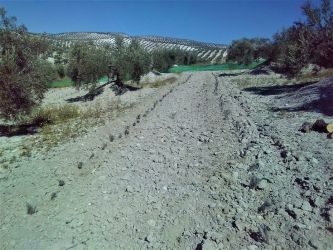The Cordoba team of the Diverfarming European crop diversification project sow lavender in the alleys of the olive grove
The strategy of crop diversification and reduction in inputs proposed by Diverfarming, a European project funded by the European Commission’s H2020 programme, in the case of the Andalusian olive groves is translated into the introduction of certain crops between the alleys that separate the rows of trees.
 After having carried out a first diversification in which saffron was planted in the alleys of one of the plots, two rows of lavender of the grosso variety have now been sown. This is a hybrid form of two types of lavender. Its compatibility with the lands that host the olive grove was checked by means of an analysis of the characteristics and needs of both crops and a series of meetings carried out in Brihuega (Guadalajara), considered as the national cradle of lavender, between the research group of the project and companies within the sector.
After having carried out a first diversification in which saffron was planted in the alleys of one of the plots, two rows of lavender of the grosso variety have now been sown. This is a hybrid form of two types of lavender. Its compatibility with the lands that host the olive grove was checked by means of an analysis of the characteristics and needs of both crops and a series of meetings carried out in Brihuega (Guadalajara), considered as the national cradle of lavender, between the research group of the project and companies within the sector.
The presence of the intercropping of lavender will lead to a decrease in erosion that causes soil loss due to the run-off that occurs on a barren land in which traditional tilling is carried out. In this way, one of the principal problems facing the olive groves today is dealt with.
Moreover, this aromatic plant attracts auxiliary fauna, an important factor in an age when biodiversity is endangered.
The resistance to dry environments and lack of water of these xerophile species that grow naturally in rocky terrains with limited organic matter will make them resist the olive grove terrain well. The benefits on the land are aimed at providing economic gains for the olive farmers and a more certain sustainability horizon.
The perfect combination: olive – lavender
In this line, the professors from the University of Jaen integrated within the UCO group, Manuel Parras, Francisco José Torres and Manuela Vega, met technicians from UPA, ASAJA, Cooperativas Agroalimentarias, IFAPA and Cooperativa San Roque de Arjonilla, in order to analyse and discuss the type of olive grove most prone for a diversification with lavender. They cocnluded that, in an exploratory manner, the olive grove should be of the traditional mechanisable or non-mechanisable type, as in the case of the demonstration olive grove that serves as the case study in the project, located in Torredelcampo, Jaen.
This case study, in addition to the UCO, counts on the participation of ASAJA Región de Murcia and Disfrimur Logística. The UCO research group, headed by the professors Luis Parras and Beatriz Lozano, lead the case study, measure the effects of the diversification in terms of erosion and productivity, together with the environmental impact and greenhouse gas emissions, and collaborate with the researchers from Jaen to study the value chain of these intercrops to know their profitability in the market.
Diverfarming is a project financed by the Horizon 2020 Programme of the European Commission, within the challenge of “Food Security, Sustainable Agriculture and Forestry, Marine, Maritime and Inland Water Research and the Bioeconomy”, which counts on the participation of the Universities of Cartagena and Córdoba (Spain), Tuscia (Italy), Exeter and Portsmouth (United Kingdom), Wageningen (Netherlands), Trier (Germany), Pecs (Hungary) and ETH Zurich (Switzerland), the research centres Consiglio per la ricerca in agricoltura e l'analisi dell'economia agraria (Italy), the Consejo Superior de Investigaciones Científicas (Spain) and the Natural Resources Institute LUKE (Finland), the agrarian organisation ASAJA, and the companies Casalasco and Barilla (Italy), Arento, Disfrimur Logística and Industrias David (Spain), Nieuw Bromo Van Tilburg and Ekoboerdeij de Lingehof (Netherlands), Weingut Dr. Frey (Germany), Nedel-Market KFT and Gere (Hungary) and Paavolan Kotijuustola and Polven Juustola (Finland)).










